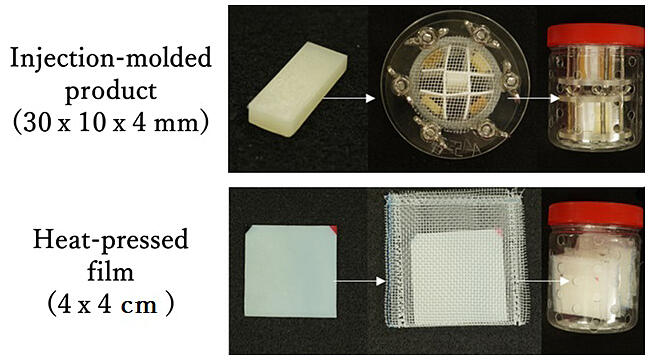A research group led by Professor Tadahisa Iwata of the Laboratory of Science of Polymeric Materials, Graduate School of Agricultural and Life Sciences at the University of Tokyo has shown that biodegradable plastics can be degraded by microorganisms, even in deep waters. This is said to be the first achievement of its kind in the world. The discovered microorganisms are known to exist in marine sediments worldwide, and it is expected that any plastic that has been shown to be degraded by microorganisms will also degrade in any oceanic region of the world, providing a potential solution to marine plastic pollution.

Provided by Professor Tadahisa Iwata of the University of Tokyo
Petroleum-derived plastics do not degrade in the natural environment and persist for decades or longer. "Microplastics," which are miniaturized versions of these plastics, are feared to have an impact on marine ecosystems and humans. For this reason, biodegradable plastics that break down completely into carbon dioxide and water through the action of microorganisms are used, but their behavior in the deep sea was not known.
Iwata and his team used the manned submersible Shinkai 6500 and the unmanned explorer Edokko-1 to transport and deposit biodegradable plastics and petroleum-derived plastics at five deep-sea floor sites near Japan. The deep-sea floor sites are located off the following places (from closest to land): Misaki Port in Kanagawa Prefecture (757 m depth), Hatsushima in Shizuoka Prefecture (855 m depth), Myojin-sho in the Izu-Ogasawara region (1,292 m depth), the deep-sea plain in Kuroshio extension (5,503 m depth), and Minamitorishima at the easternmost tip of Japan (5,552 m depth).

Provided by Professor Tadahisa Iwata of the University of Tokyo
In total, 18 types of biodegradable plastic samples were deposited; that is, four types of microbially produced polyesters (polyhydroxyalkanoates or PHAs); five types of biodegradable polyesters, such as polylactic acid; and nine types of polysaccharide ester derivatives, including cellulose acetate. The four types of petroleum-based plastics included polypropylene and polyethylene terephthalate, used for plastic bottles.
Samples that had been in the deep sea for 3-14 months were pulled up, weighed, and measured for thickness, and the surfaces were examined with a scanning electron microscope. Most of the biodegradable plastic surfaces were covered with numerous microorganisms, which caused protrusions and recesses on the surface due to their degradation activity. In contrast, the petroleum-derived plastics and polylactic acid showed no signs of microbial attachment or degradation.
A comparison of biodegradation rates in deep water and on shore showed that the rate at a depth of 1,000 meters was one-fifth to one-tenth of that onshore, whereas the rate at a depth of 5,000 meters was approximately one-twentieth of that on shore. These differences are speculated to be related to environmental changes, such as water pressure and temperature, and the amount and diversity of microorganisms present. A plastic bag made of PHA would biodegrade in 3 weeks to 2 months at a depth of 1,000 m.

Provided by Professor Tadahisa Iwata of the University of Tokyo
Through genetic analysis, many new microorganisms capable of degrading biodegradable plastics have been discovered in the deep sea. It has been confirmed that they are listed in a database of microorganisms found in marine sediments collected from around the world.
Iwata said, "The degradation of polylactic acid requires a specific temperature and humidity, which makes its degradation in the deep sea difficult. Other biodegradable plastics also degrade at different rates in deep water. It is necessary to distinguish between different uses, taking into account factors such as ease of recovery and how long the material can remain in the environment with minimal impact."
The research was conducted in collaboration with the Japan Agency for Marine-Earth Science and Technology (JAMSTEC), Gunma University, the National Institute of Technology and Evaluation, the National Institute of Advanced Industrial Science and Technology, and the Japan BioPlastics Association. The research results were published on January 26 in the online edition of the British scientific journal Nature Communications.
Original article was provided by the Science Portal and has been translated by Science Japan.




